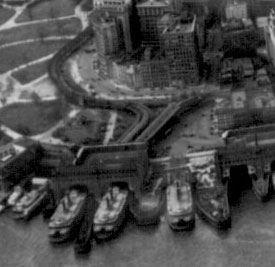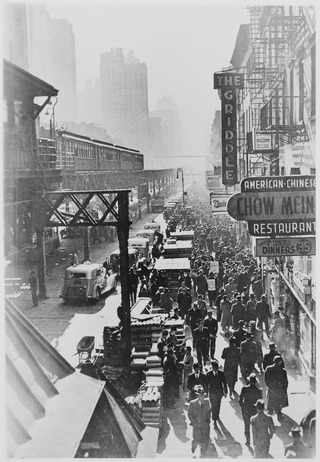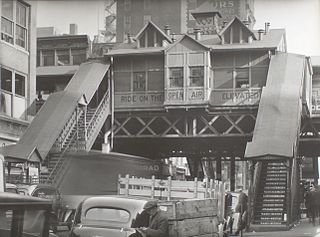
The Independent Subway System, formerly known as the Independent City-Owned Subway System (ICOSS) or the Independent City-Owned Rapid Transit Railroad (ICORTR), was a rapid transit rail system in New York City that is now part of the New York City Subway. It was first constructed as the Eighth Avenue Line in Manhattan in 1932.

The South Ferry station was an elevated station at the southern terminal of the IRT Second, Third, Sixth and Ninth Avenue Lines. It was located next to Battery Park at the lower tip of Manhattan, New York City. Two tracks came from the combined Second and Third Avenue Lines, and two from the Sixth and Ninth Avenue Lines, making four tracks at the terminal, with platforms on the outside and between each pair of tracks.

The IRT Sixth Avenue Line, often called the Sixth Avenue Elevated or Sixth Avenue El, was the second elevated railway in Manhattan in New York City, following the Ninth Avenue Elevated.
The Battery Place station was a station on the demolished Ninth Avenue and Sixth Avenue elevated train lines in Manhattan, New York City. It was located at the southern terminus of Greenwich Street at the north end of Battery Park.
The Rector Street station was on the demolished IRT Sixth Avenue Line in Manhattan, New York City. It had three tracks and two side platforms. It opened on June 5, 1878, served by trains from the IRT Sixth Avenue Line, and was one block east of Rector Street El Station on the IRT Ninth Avenue Line. In 1918, Brooklyn Rapid Transit Company built the Broadway Subway through Manhattan and added a station at Rector Street, which served as competition for the 6th Avenue Line station. The el station closed on December 4, 1938. The next southbound stop was Battery Place on the IRT Ninth Avenue Line. The next northbound stop was Cortlandt Street.

The Cortlandt Street station was a station at Church Street on the demolished IRT Sixth Avenue Line in Manhattan, New York City. It had 3 tracks and two side platforms. It was served by trains from the IRT Sixth Avenue Line and opened on June 5, 1878. It closed on December 4, 1938. The next southbound stop was Rector Street. The next northbound stop was Park Place.

The Park Place station was a station on the demolished IRT Sixth Avenue Line in Manhattan, New York City. It had 2 tracks and two side platforms. It was served by trains from the IRT Sixth Avenue Line and opened on June 5, 1878. It closed on December 4, 1938. The next southbound stop was Cortlandt Street for local trains, and Battery Place for express trains. The next northbound stop was Chambers Street for all trains. The Chambers Street – World Trade Center / Park Place station complex can be found within the vicinity of the former elevated railroad station.
The Chambers Street station was a station on the demolished IRT Sixth Avenue Line in Manhattan, New York City. It had two tracks and two side platforms. It was served by trains from the IRT Sixth Avenue Line and opened on June 5, 1878. It closed on December 4, 1938. The next southbound stop was Park Place. The next northbound stop was Franklin Street. The Chambers Street – World Trade Center / Park Place station complex can be found within the vicinity of the former elevated railroad station.
The Franklin Street station was a station on the demolished IRT Sixth Avenue Line in Manhattan, New York City. It was located at Franklin Street and West Broadway, and it had two tracks and two side platforms. There was space for two additional tracks in the station. South of the station there are two additional tracks that served to layup trains.
The Grand Street station was a station on the demolished IRT Sixth Avenue Line in Manhattan, New York City. It had two tracks and two side platforms. It was served by trains from the IRT Sixth Avenue Line and opened on June 5, 1878. It closed on December 4, 1938. The next southbound stop was Franklin Street. The next northbound stop was Bleecker Street.
The Bleecker Street station was a station on the demolished IRT Sixth Avenue Line in Manhattan, New York City. It had two tracks and two side platforms. It was served by trains from the IRT Sixth Avenue Line and opened on June 5, 1878. It closed on December 4, 1938.

The 14th Street station was a station on the demolished IRT Sixth Avenue Line in Manhattan, New York City. It had two tracks and two side platforms, and was served by trains from the IRT Sixth Avenue Line. The station opened on June 5, 1878, and was designed by famed Hudson River School painter Jasper Francis Cropsey, a trained architect. Beginning in 1907, the station had a connection to the 14th Street subway station of the Hudson and Manhattan Railroad. It closed on December 4, 1938. The next southbound stop was Eighth Street. The next northbound stop was 18th Street. Two years later the station was replaced by the IND Sixth Avenue Line platforms of the 14th Street / Sixth Avenue Subway station complex.
The 18th Street station was a station on the demolished IRT Sixth Avenue Line in Manhattan, New York City. It had two tracks and two side platforms. It was served by trains from the IRT Sixth Avenue Line and opened in 1892. It closed on December 4, 1938, and was not replaced with a subway station on the IND Sixth Avenue Line. However, one block north of the station there was a 19th Street station on the Hudson and Manhattan Railroad that operated between 1908 and 1954. The next southbound stop was 14th Street. The next northbound stop was 23rd Street.

The 23rd Street station was a station on the demolished IRT Sixth Avenue Line in Manhattan, New York City. It had two tracks and two side platforms. It was served by trains from the IRT Sixth Avenue Line. This station opened on June 5, 1878 and closed on December 4, 1938. The next southbound stop was 18th Street. The next northbound stop was 28th Street. Two years later the rapid transit needs of the intersection were replaced by the underground 23rd Street IND subway station.

The 28th Street station was a station on the demolished IRT Sixth Avenue Line in Manhattan, New York City. It had two tracks and two side platforms. It was served by trains from the IRT Sixth Avenue Line. This station opened in 1892. From 1910 to 1937 it also had a connection to the 28th Street. It closed on December 4, 1938. The next southbound stop was 23rd Street. The next northbound stop was 33rd Street.

The 33rd Street station was a station on the demolished IRT Sixth Avenue Line in Manhattan, New York City. It had two tracks and two side platforms. It was served by trains from the IRT Sixth Avenue Line. This station opened on June 5, 1878, and closed on December 4, 1938. The next southbound stop was 28th Street. The next northbound stop was 38th Street. The station was eventually replaced by the 34th Street–Herald Square Subway station complex one block north.

The 42nd Street station was a station on the demolished IRT Sixth Avenue Line in Manhattan, New York City. It had 2 tracks and two side platforms. It was served by trains from the IRT Sixth Avenue Line, and was located near sites such as the New York Public Library headquarters, Bryant Park, and the New York Hippodrome. The station opened on June 5, 1878, and closed on December 4, 1938. The next southbound stop was 38th Street. The next northbound stop was 50th Street. Two years later, the rapid transit needs of the intersection were replaced by the IND Sixth Avenue Line platforms of the 42nd Street–Bryant Park/Fifth Avenue subway station complex.
The 50th Street station was a station on the demolished IRT Sixth Avenue Line in Manhattan, New York City. It had two tracks and two side platforms. It was served by trains from the IRT Sixth Avenue Line and opened on June 5, 1878. It closed on December 4, 1938. The next southbound stop was 42nd Street. For some trains, the next northbound stop was 58th Street Terminal until 1924, while for other trains, the next northbound stop was Eighth Avenue. For express trains, the next northbound stop was 66th Street on Ninth Avenue. Two years later after the station closed, it was replaced by the nearby underground 47th–50th Streets–Rockefeller Center subway station.
The 53rd Street and Eighth Avenue station was a station on the demolished IRT Sixth Avenue Line in Manhattan, New York City. It was built in 1881 by the Manhattan Railway Company as part of an effort to connect the northern end of the Sixth Avenue Line to the Ninth Avenue Line. It had three tracks and two side platforms, and was served by trains from the IRT Sixth Avenue Line. As a result, it became the last station on the Sixth Avenue Line before merging at a sharp curve with the Ninth Avenue Line. On September 11, 1905, 12 people were killed and 42 injured when a train jumped over the rails at the curve on 53rd Street between the Ninth Avenue 50th Street and 59th Street stations. In 1932, the Independent Subway System built the 50th Street Station three blocks to the south on the Eighth Avenue Subway with an additional lower level in 1933, thus rendering the elevated station and line obsolete. It closed on December 4, 1938. The next southbound stop was 50th Street. The next northbound stop was 59th Street.

The 14th Street/Sixth Avenue station is an underground New York City Subway station complex in Greenwich Village and Chelsea, Manhattan, on the IRT Broadway–Seventh Avenue Line, the BMT Canarsie Line and the IND Sixth Avenue Line. It is located on 14th Street between Sixth Avenue and Seventh Avenue. It is served by the 1, 2, F, and L trains at all times, by the 3 train at all times except late nights, the M train during weekdays, and the <F> train during rush hours in the peak direction.











